MARCH OF THE TITANS - A
HISTORY OF THE WHITE RACE
CHAPTER 6 : TO THE ENDS OF THE
EARTH -
LOST WHITE MIGRATIONS
China, Japan, Canary Islands
In addition to the great White Indo-European migrations,
several other waves of White migration occurred, varying in number, influence and spread -
the most spectacular being a White settlement in North America dating from approximately
7000 BC.
Knowledge of these migrations has been lost for centuries -
in some cases thousands of years - but due to relatively recent archeological finds, have
now been rediscovered. In this way Nordic and White Mediterranean remains - sometimes
preserved naturally, sometimes preserved through artificial means - have been discovered
in China, the Canary Islands and in North America - most of them many thousands of years
old.
The discovery of these mummies shows without question that
early White migrations across seas and continents took place - it is just the exact
numbers of individuals who undertook these migrations which is still a matter of debate.
The Tocharians - The Great Lost White Civilization
in China
One of the furthermost eastern migrations of Celtic peoples
- Indo-European Nordics - reached the Takla Makan desert (situated between Kazakhstan,
Kyrgyzstan and Tibet) in China around 1500 BC.
This great migration was unknown until the 1977 AD
discovery of 3500-year-old graves of these people. As a result of the natural dryness of
the environment, many of the corpses are almost perfectly preserved, with their
reddish-blond hair, long noses, round eyes and finely woven tartan clothing (usually
associated with the Celts in Scotland), showing undeniably White racial traits.
These people have become known by the language which they
spoke: Tocharian. The civilization which they built consisted of great cities, temples,
centers of learning and art - they were also the builders and maintainers of the original
Silk Road - the path for trade between the West and China itself.
It was originally thought that the Chinese built the great
cities along the Silk Road, but the discovery of the remains of the original people of
this region now shows that the impressive ruins which still lie, undisturbed, along that
road, are the remains of a great lost White civilization.
The first White mummy in the region was discovered by
accident in 1977 after shifting sands uncovered a female corpse whose body had been
mutilated, presumably in some act of war.
Excavation around her corpse uncovered a further 16
mummies, so perfectly preserved by the desert that traces of tears were found on the face
of a mummified infant. Fully dressed bodies have been found wearing finely woven woolen
textiles with Celtic patterns, leather shoes and jewelry. The desert conditions proved so
exceptional that even pieces of bread used as offerings were preserved intact alongside
what is the world's oldest saddle.
In one grave, excavators discovered a saddle cover and a
pair of trousers with drawings of humans on one leg - one face had blue eyes.
The
Tocharians: the great lost White migration to China. The Chinese civilization always
contained stories of blue eyed and blonde haired leaders who were the originators of
Buddhism and who were the first leaders and organizers of Chinese society. These stories
were always regarded as pure legend until the 1977 discovery of the graveyards of the
Tocharians in the Takla Makan desert in China. The Tocharian mummies - naturally preserved
in the dry desert sands are unequivocally clear Nordic racial types. The graveyards lie
near the ruins of the great Tocharian cities, built along the famous Silk Route. It is
beyond doubt that Whites settled in China, and the Chinese legends of White influence on
that civilization may yet have some basis in fact.

The first Tocharian Nordic mummy
to be found: a White female with long blond hair.
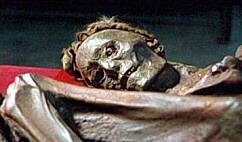
A Tocharian man with red-blond
hair.
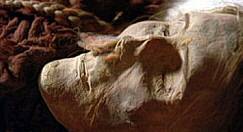
A close up of another Tocharian
female mummy. Her tall stature, high nose, and red hair are all clear Nordic traits. |
By the early 1990s, over a thousand Nordic corpses had been
uncovered from the grave yards in the region (called Wapu); but by 1998, the Chinese
government had halted further archeological expeditions to the area, quite likely for fear
of exposing yet more ancient European faces to the world.
The current inhabitants of the surrounding lands, who are
already obviously not pure Chinese and who even speak a form of Turkish, rather than
Chinese, have been agitating for independence for some time.
The discovery of the White mummies has served to highlight
their racial and ethnic differences from the Chinese and the issue has become a political
hot potato for that country's government.
However, some of the mummies which have already been
uncovered are still on display in a local museum, while others lie in storerooms slowly
deteriorating.
The new finds are forcing a re-examination of old Chinese
books that describe historical or legendary figures of great height, with deep-set blue or
green eyes, long noses, full beards, and red or blond hair. Scholars have traditionally
scoffed at these accounts, but it now transpires that these accounts were correct.
While it is unknown as to what the exact influence these
Whites had upon the Chinese civilization, it has been the subject of speculation - based
upon old Buddhist manuscripts - that the tenets of the Buddhist religion may have been
brought to the Far East by these Tocharian Celts.
The existence of the Tocharians may also explain another
great mystery of China: the existence of step pyramids near the city of Xian in Qui Chan
province. These pyramids are without precedent in China but which were common to White
civilizations.
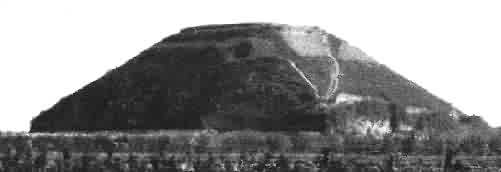
One of a number of European style step pyramids
(similar to Silbury Hill, England - see chapter 3) which can be found in near the city of
Xian, Qui Chauan province, China. Can these mysterious - and very un-Chinese - structures
be linked to the Tocharians? Another tantalizing clue of Indo-Europeans in China is the
fact that the swastika - the ancient Sanskrit symbol for well being - is also common in
China as a good luck charm.
THE DISAPPEARANCE OF THE TOCHARIANS
With the advent of time, these White peoples mixed with
Mongolian tribes surrounding them, and so in this way vanished - but the physical features
of the people living in this part of China show very clearly part White and part Mongol
traits - and differ substantially from other inhabitants of China, with blond hair not
being unknown amongst them.
Once again, these present day physical features are the
living proof of yet another great lost White migration. Thus it was that the White
civilization of China vanished through racial mixing. Only the crumbling ruins of their
cities and their corpses remain as silent witnesses of their era.
The Ainu in Japan
The Ainu are most commonly called an aboriginal people of
Japan, occupying parts of the Japanese island of Hokkaido and the Russian islands of the
Kurils and Sakhalin (which used to be Japanese territory).
The most striking thing about the Ainu is that they differ
still to this day physically and linguistically from the rest of the Japanese population.
Although full blooded Ainu are scarce due to a large amount
of intermarriage, the Ainu display in fact distinct traces of White ancestry - typical
Ainu have a long skull, a light complexion, a heavy beard (facial hair is virtually
unknown amongst the pure Mongolian races) and thick, wavy hair. The Ainu are famous
amongst the Japanese for having body hair as well - so that they are derogatively called
the "hairy Ainu". Only one other race on earth possesses body hair to this
extent - the White Race.
The Ainu - or White - racial
influence is very evident in the Japanese upper classes: Below is a comparison of Ainu
descended Japanese nobles with a "pure" Japanese Yayoi racial type which makes
the distinction obvious.
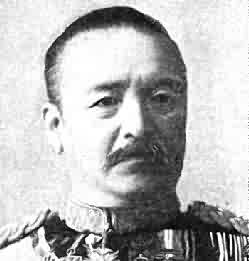
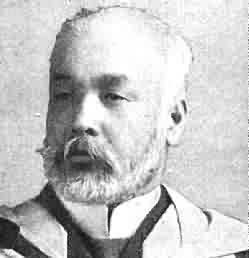
![jap3.jpg]()
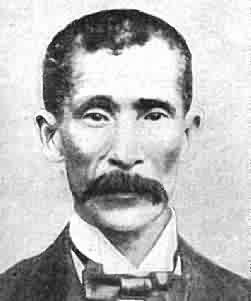
Ainu
ancestry......................... Ainu Ancestry.................... Ainu
Ancestry......................Yayoi (Mongol) Ancestry
From left to right: Count
Katsuka, Prime Minister of Japan from 1901-1905; Count Hayahsi, Japanese Minister of State
for Foreign Affairs, 1908; Prince Arisugawa, one of the Imperial Princes of Japan, 1908;
and lastly Count Komuka, Japanese ambassador to Britain in 1908.
The first three have obvious
Ainu/White ancestry, while the last is predominantly Yayoi, or of more pure Mongoloid
stock. This racial distinction in Japanese society is visible to this day - lasting
evidence of yet another lost White migration to lands usually thought of as having no
prior contact with Whites.
The Ainu language is unique, and not related to Japanese or
any other Asian language. The origins of the Ainu are obscure. They appear to have entered
Japan through the Hokkaido Island in the Yayoi Period (300 BC to 250 AD) of Japanese
history, and migrated also into the northern and eastern parts of Japan's main island
Honshu.
As the rulers of Yamato Japan started to expand their
territory eastwards around 500 AD, the Ainu were constantly displaced to the north or
mixed with the Japanese. In the Meiji Period (1868-1912) they received the status of
former Aboriginals but were strongly discriminated against. The Ainu were first mentioned
in a Japanese account in 642 AD, and they were first reported in Europe in 1586.
The American anthropologist C. Loring Brace, University of
Michigan, (Science Frontiers #65, Sep-Oct 1989) reported that "pure-blooded Ainu are
easy to spot: they have lighter skin, more body hair, and higher-bridged noses than most
Japanese." Brace studied the skeletons of about 1100 Japanese, Ainu, and other Asian
ethnic groups and has concluded that the revered samurai of Japan are actually descendants
of the Ainu, not of the Yayoi (original Mongolian) from whom most modern Japanese are
descended. Brace said further that "...this explains why the facial features of the
Japanese ruling class are so often unlike those of typical modern Japanese. The
Ainu-related samurai achieved such power and prestige in medieval Japan that they
intermarried with royalty and nobility, passing on Ainu blood in the upper classes, while
other Japanese were primarily descended from the Yayoi."
The Guanches of the Canary Islands
Off the coast of West Africa lie the Canary Islands - this
region became home to a mysterious group of Nordics in antiquity who became known as the
Guanches.
While it is unknown for sure how they arrived on the
islands, what is known is that they shared a number of cultural characteristics with the
ancient Egyptians and that their building style appears to have been replicated in South
and Central America.
Like the Celtic Tocharians, the finest evidence of what
these original Guanche Nordics looked like, is in the fortuitous existence of original
Guanche mummies, which are on public display in that island group's national museum. The
corpses on display are estimated to be between 600 and 1000 years old.
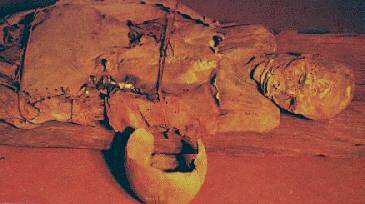
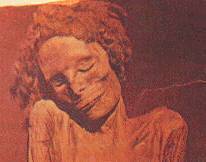
Two Guanche mummies, with red hair and other
Nordic features - the original inhabitants of the Canary islands. It is unknown at what
date they settled the islands, but show cultural similarities with the Ancient Egyptians.
An examination of one of the mummies' bodies showed
incisions that virtually matched those found in Egyptian mummies, although the string used
by the Guanche embalmers to close the wounds was much coarser than would have been used by
the Egyptian experts.
The Guanches also possessed the art of writing, although
this has not yet been the subject of any major study.
THE GUANCHE PYRAMIDS
However, the most stunning link between the Guanches and
the Egyptians comes in the form of pyramids - the Guanches built several small step
pyramids on the islands, using exactly the same model as those found in ancient Egypt and
in Mesopotamia. The pyramids have an east-west alignment which also indicates that they
probably had a religious purpose, associated with the rise and setting of the sun.
Carefully built stairways on the west side of each pyramid
lead up to the summit, which in each case has a flat platform covered with gravel,
possibly used for religious or ceremonial purposes.
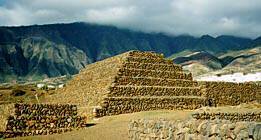
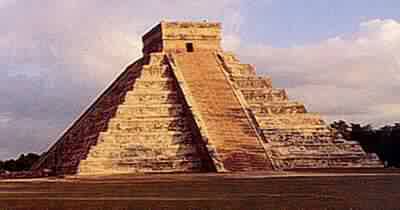
Left: One of the Pyramids of Guimar, Canary
Islands. Right: A Mayan pyramid in Central America (Chichen Itza). The resemblance is
unmistakable. There is strong evidence to suggest that Whites used the Canary Island
current to cross the Atlantic Ocean and influence the Central and Southern American
civilizations in pre-Columbian times.
THE SIGNIFICANCE OF THE GUANCHE PYRAMIDS
The famous explorer, Thor Heyerdahl, who
"rediscovered" the pyramids on the Canary Islands and who set up an academic
body to study the phenomena, argued that the pyramids may be remains from explorers who
sailed the Atlantic in ancient times, and who may have possibly forged a link with the
pre-Columbian civilizations of the Americas.
As the original inhabitants of the Canary Islands were
fair-haired and bearded, it was possible, Heyerdahl suggested, that long before the 15th
Century, people of the same stock as those who settled the Canary Islands, also sailed the
same route along the Canary Current that took Christopher Columbus to the Americas.
This theory formed the basis of Heyerdahl's famous
"RA" expeditions in which he showed that is was possible to cross the Atlantic
in an Egyptian reed boat.
In fact Columbus' starting off point was the Canary
Islands, where he obtained supplies and water on Gomera, the island next to Tenerife. The
Guanches on Tenerife in 1492 did not permit Columbus to land on their island - they were
not impressed by the physical appearance of the bearded Europeans, who looked like the
Guanches themselves.
When Columbus and the Europeans who followed in his wake
landed in the Americas, they were welcomed and initially worshiped as gods, since the
beardless Indians they encountered believed that the Spanish belonged to the same people
as the legendary founders of their civilization, bearded men from across the Atlantic
Ocean.
According to the Aztec and Olmec (Central American Amerind)
legends, their god, Quetzalcoatl, had Nordic features (eyes and hair color) and a beard.
This god came from over the sea and taught the Amerinds how to raise corn and build
structures.
There is indeed a marked similarity between the step
pyramids to be found on the Canary Islands and those to be found in Central and South
America, strongly suggesting yet another great lost White migration, this time to Central
and South America, perhaps a thousand years or more before Columbus.
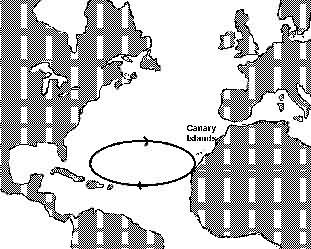
The position of the Canary Islands and the
route of the Canaries Current to and from the Americas. The existence of the red haired
Guanches on the Canary Islands, combined with the red haired pre-Columbus mummies found in
South America and the marked similarity in pyramid building styles, indicate that Whites
probably used the Canaries Current to cross the Atlantic, most likely between 2000 and 500
BC. Columbus himself used the Canaries Current, setting out from the Canary Islands on his
first crossing of the Atlantic in 1492 AD.
There is also clear evidence from the Mexican side of the
Atlantic Ocean that Whites - blond haired Whites - reached that part of the world long
before the Spanish explorations of the late 1490s.
Below is a pre-Columbian wall painting which can be found
in the Temple of the Warriors, Chichen Itza, on the east coast of Mexico. The first
depicts White prisoners after their capture by the dark skinned natives, and the second,
shows a White man with long blond hair being sacrificed by the Nonwhites. It is worthwhile
to remember that these paintings date from BEFORE Christopher Columbus sailed the Atlantic
in 1492.
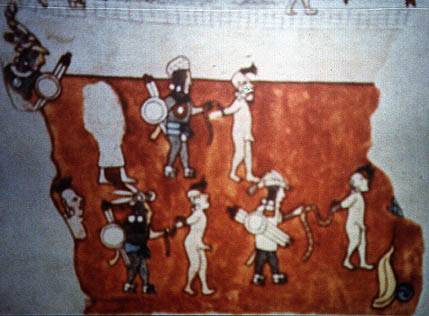
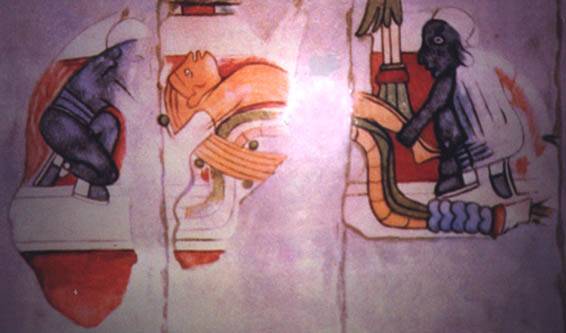
The wall painting above, has been reconstructed as an
actual scene (photo below) and is on display at the Parque Etnografico, the museum set up
on the Canary Islands around the site of the pyramids which is open to the public.
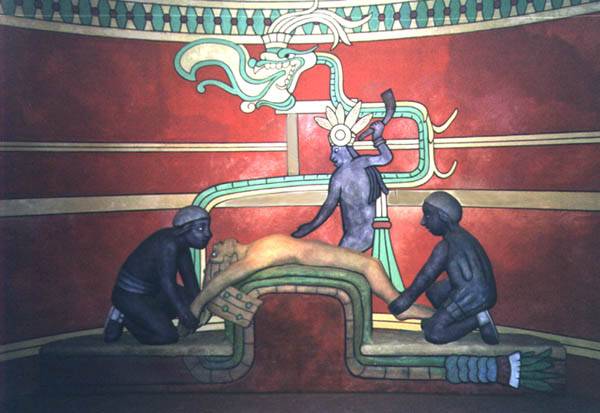
THE DISAPPEARANCE OF THE GUANCHES
Guanche artifacts, such as cave murals, tombs, stone and
mortar walls, broken pottery and other everyday items are abundant on the island. Similar
artifacts have been found on the African continent itself - notably in Morocco, indicating
that at some stage the Guanches crossed the sea to Africa.
There they started mixing with Arabic and other Nonwhite
racial types on the African continent itself. This process is very likely to be the cause
of some flashes of blond hair and light colored eyes still to be found amongst the Berber
population of north west Africa to this day.
The pyramids and other structures on the islands seem to
have been constructed by an advanced people - certainly by the time of the Spanish
invasion, the Guanches had lost much of their civilized apparel, and Spanish accounts have
it that they were attacked by naked tribesmen, who sometimes inflicted serious military
defeats upon the invading Spaniards. It was only in 1496 that the Spaniards finally
defeated the last of the Guanches.
The arrival of the White Spanish in the mid 14th Century
saw the remaining Nordic Guanches absorbed into the new settler population. The blond,
blue-eyed, tall stock has been preserved in part, and can still be seen today in many
individuals on the island. Culturally speaking, the Guanche civilization was completely
absorbed by the imported continental European culture, so that the Canary Islands remains
Spanish territory to this day.
Part Two : North America
Part Three: South America
or back to
White History
main page
or
All material (c) copyright Ostara Publications, 1999.
Re-use for commercial purposes
strictly forbidden.












